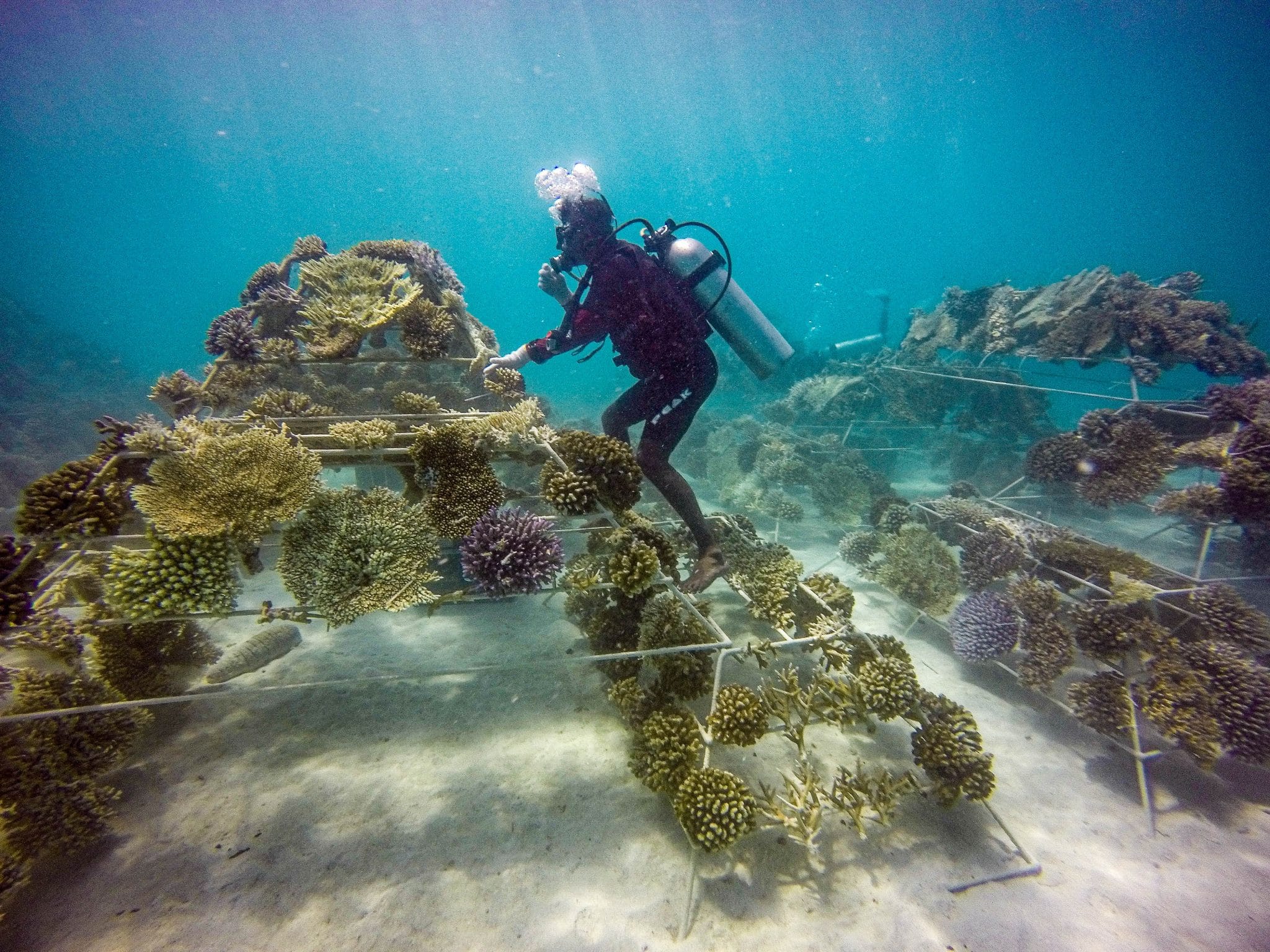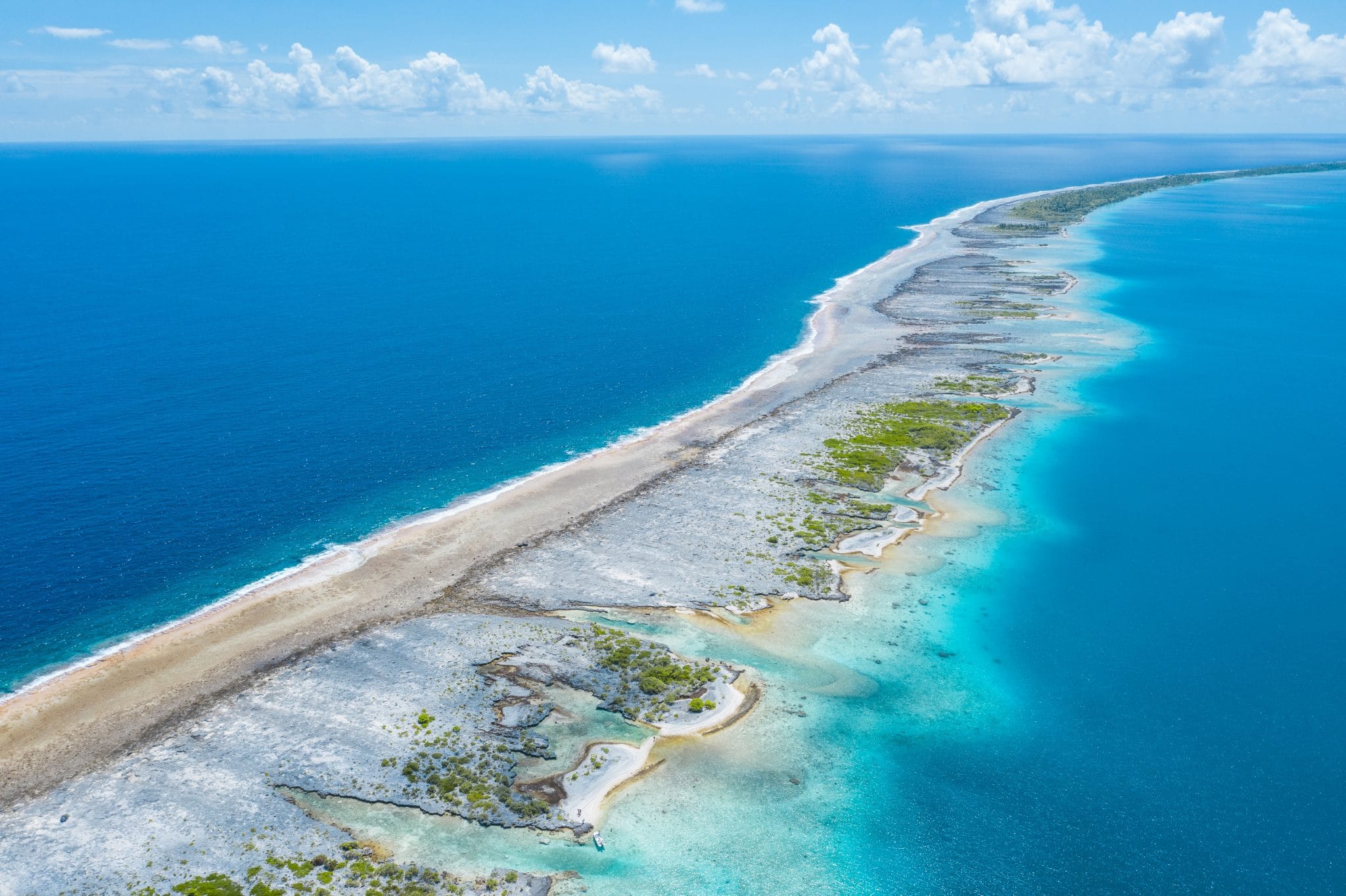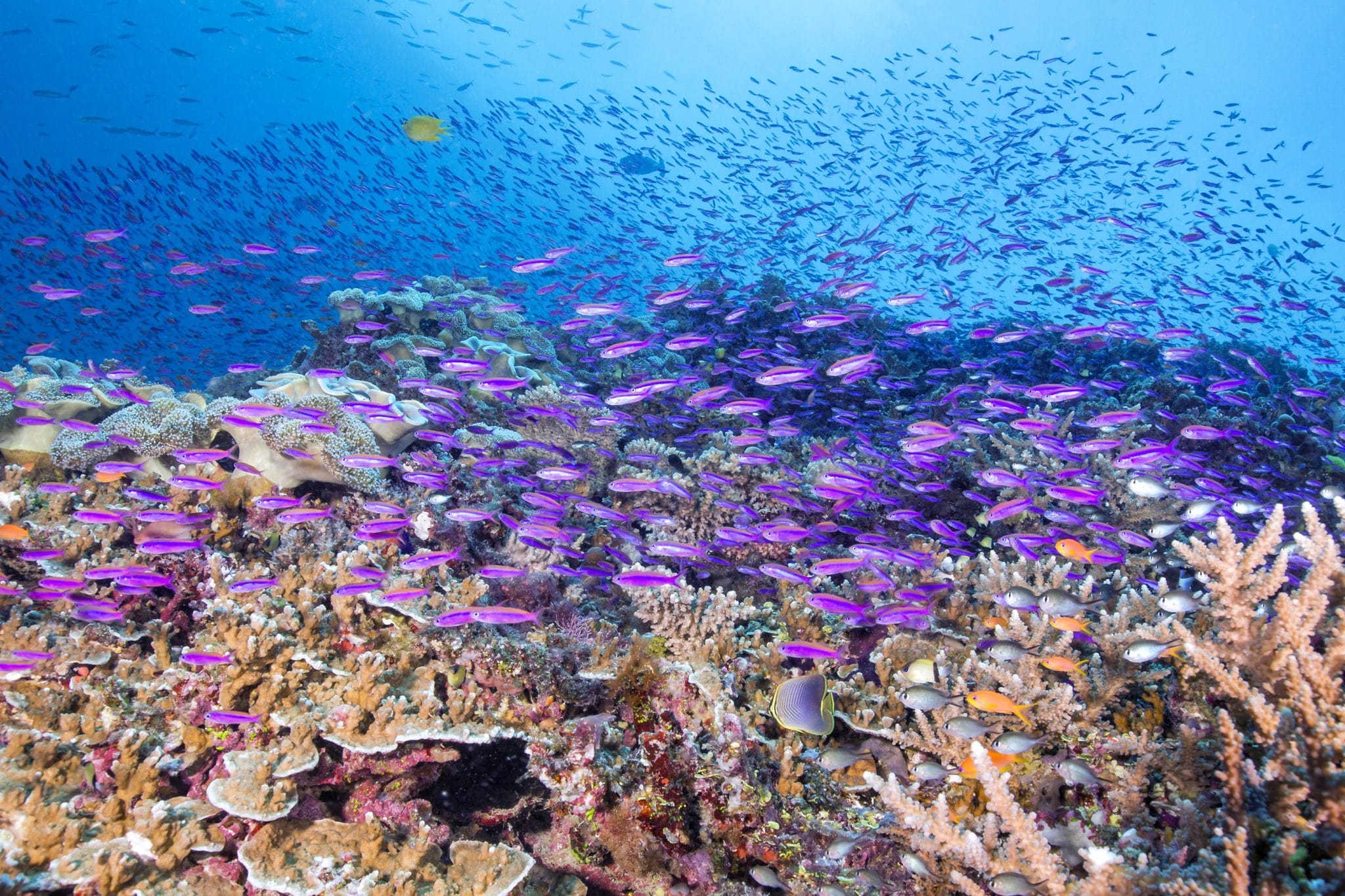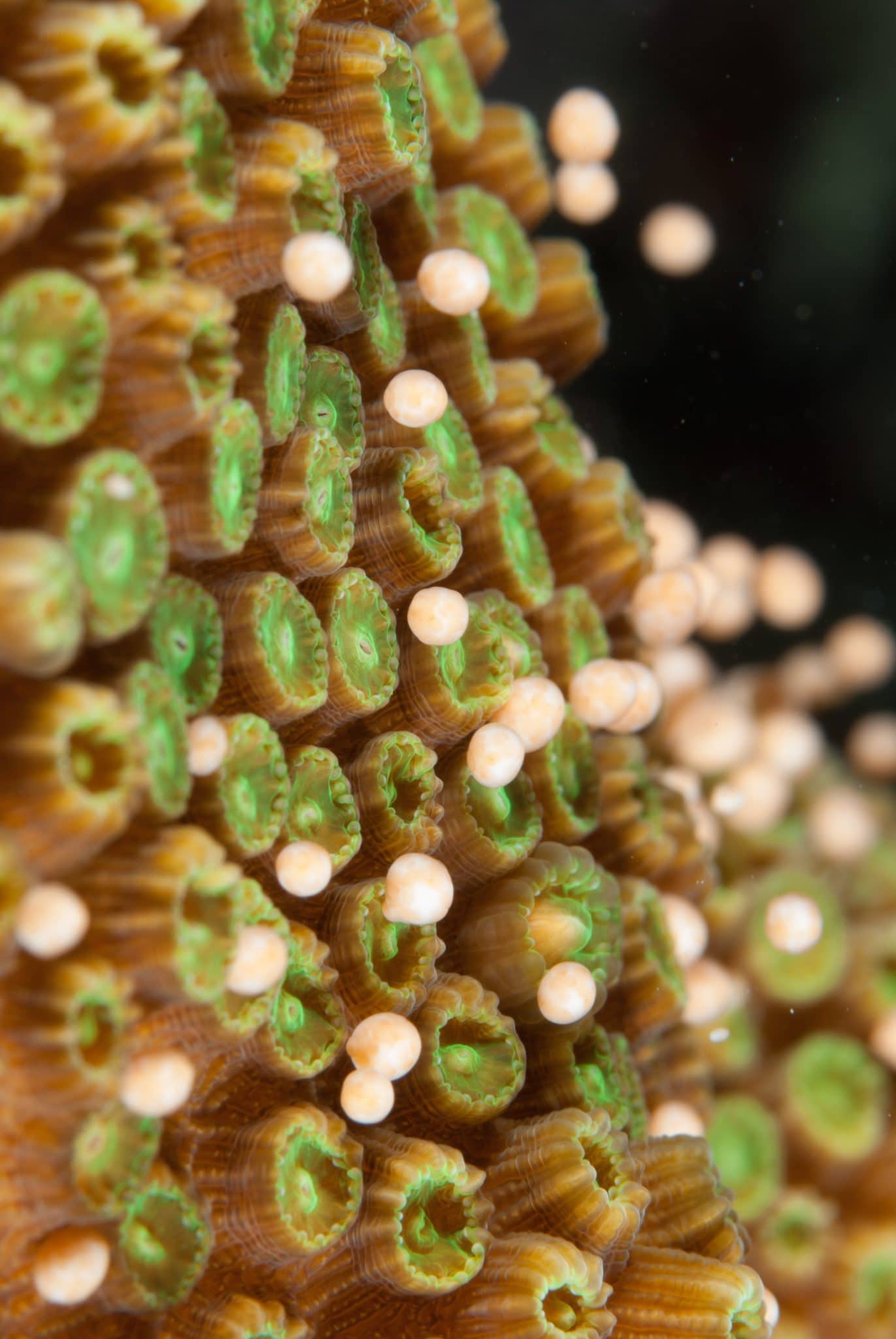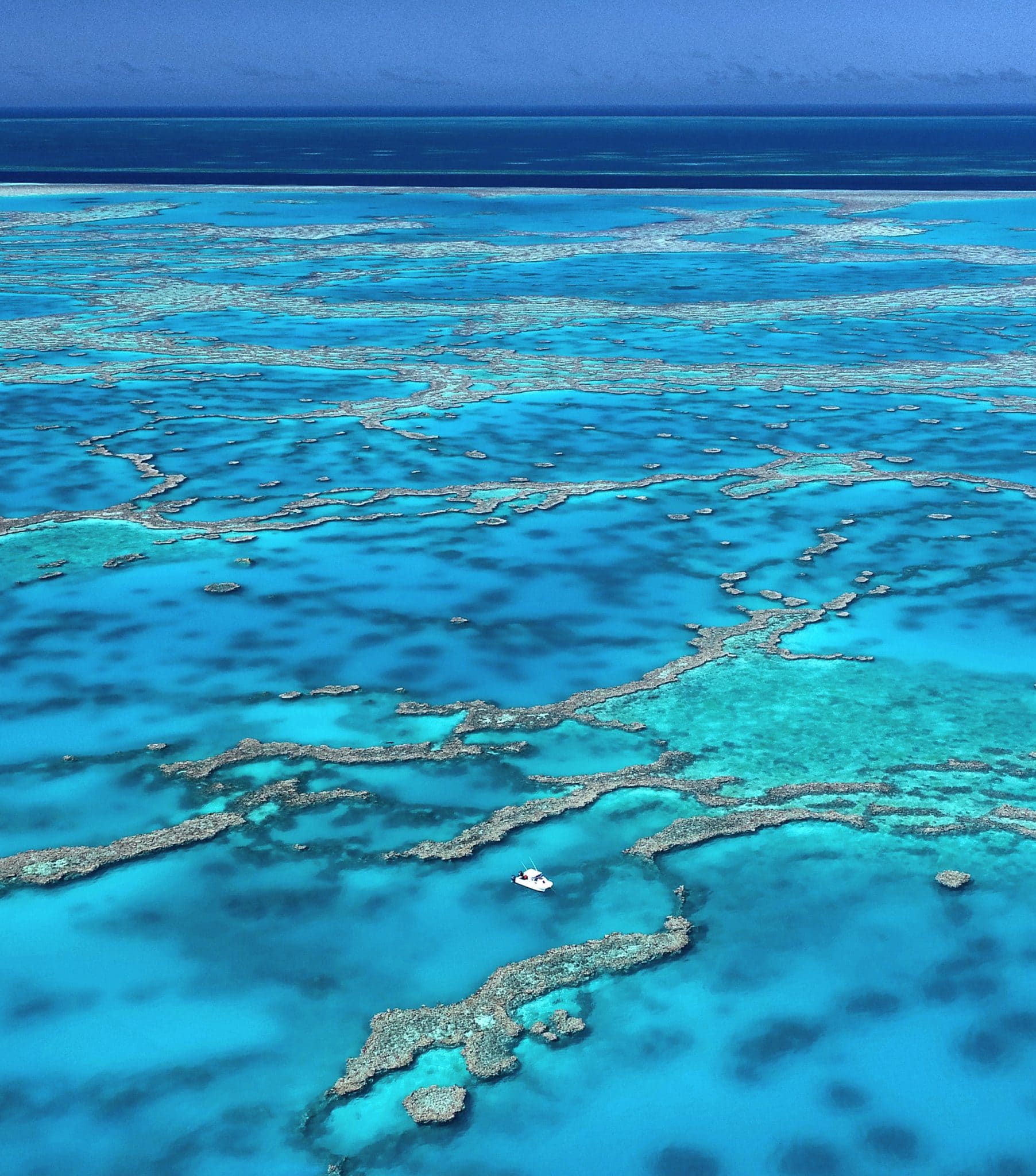Marine Life & Conservation Blogs
World Reef Day: Best Reef Conservation projects and dives from around the world
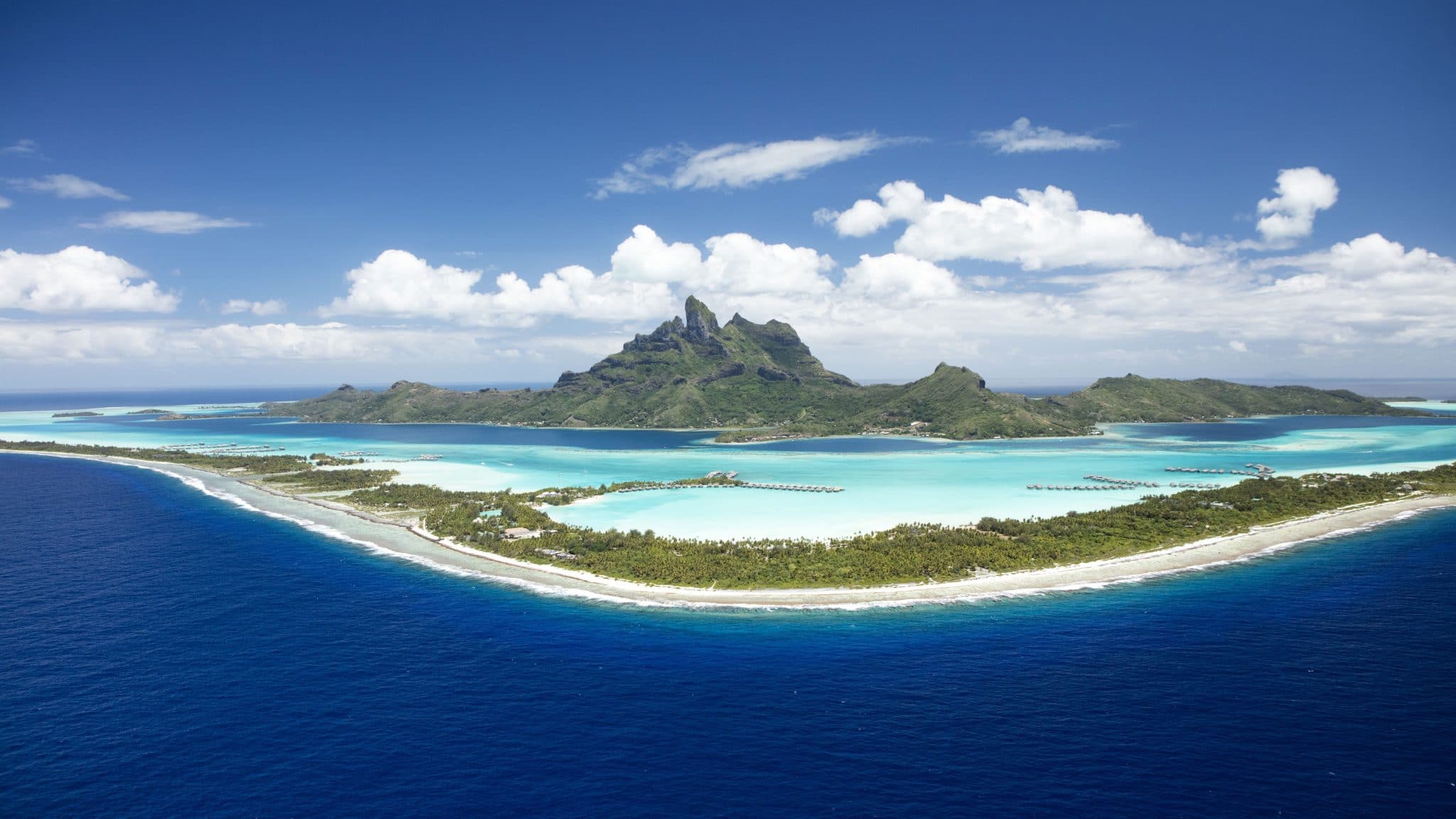
Top Coral Reef Hope Spots
Around the world, destinations are running coral conservation programs that both local communities and visitors can play a direct role in. The results so far have been nothing short of inspiring, proving that hope is not lost in saving coral. Here are PADI’s top coral reef hope spots and how you get involved next time you visit.
1. Maldives: Adopt a Coral Program
PADI Dive Resort Sheraton Maldives Full Moon & Spa is empowering guests to plant hope and become coral champions during their stay. Known as “Adopt a Coral”–which is part of Good Travel with Marriott Bonvoy in collaboration with Reefscapers, the goal is the program is to invite guests to help in planting coral on one of the largest man-made coral structures in the Maldives. Families can also take part in guided house reef snorkeling tours with the resort’s in-house marine biologist Amélie Carraut and kids can take part in her Little Marine Biologists for the day.
2. Tahiti: Pristine Reef Discoveries
Hope was certainly found in Tahiti at the beginning of 2022, when PADI Divers and scientists discovered one of the largest healthy reefs now on record, with two miles of rose-shaped coral spanning the ocean floor as deep as 100ft! The discovery has reminded us all of the importance of exploration and the role it plays in scientific discoveries that can help create ocean change.
Further supporting a healthy coral reef ecosystem in Tahiti are the Coral Gardners, a program designed to plant one million corals and restore life back into the ocean. You can even adopt or gift ten different species of coral and receive growth updates.
3. Fiji: Communities Championing Coral Restoration
Did you know that Fiji is home to 42% of the world’s coral species that span over 10,000 square kilometers throughout the country? There is a reason why the destination is known as the “Soft Coral Capital of the World” and there are numerous coral restoration projects dedicated to preserving it.
In partnership with Fiji’s Ministry of Fisheries, the non-profit Aquaculture Development for the Environment has launched the One Million Coral Planting Program throughout the 333 islands of Fiji. Teaming up with over 20 different coastal villages, each community has a target of collectively planting 1,000 corals per week.
There are also numerous resorts that have programs designed on educating visitors on how they can play a role in rejuvenating and protecting the surrounding coral reefs they are visiting. One of the best places to do this is at PADI Dive Resort Jean-Michel Cousteau Fiji, where their onsite marine biologist teaches guests how to coral plant and help nurse nearly 100 fragments of live coral back to full health.
For those visiting with families, PADI Dive Resort Outrigger Fiji has one of the best reef restoration programs for youth, who host a coral conservation program for kids and teens every Wednesday–with the goal of having them return back home as official eco-warriors.
4. Bonaire: The Coral Pledge to Tourists
The island nation of Bonaire has created a pledge known as ‘The Bonaire Bond’ to help preserve and protect its natural beauty above and below the surface of their surrounding tropical waters.Those who visit the island are asked to sign their pledge to respect the island’s rules designed to help sustain the environment; in return, Bonaire pledges to adopt coral trees through Reef Renewal Bonaire for every visitor who signs the pledge, with the long-term goal of restoring both the coral reefs surrounding the island and marine animals who call it home. Each coral tree is predicted to help nurture 100 pieces of coral.
5. Australia: Become a Reef Ranger at the Great Barrier Reef
Australia’s greatest natural icon–the Great Barrier Reef– stretches 2300 km down Queensland’s coastline and covers more than 344,400km in total. Did you know that the Great Barrier Reef is also the only living organism that can be seen from space and is bigger than the countries of the UK, Switzerland, and Holland combined?
You can become an actual Reef Ranger for the Great Barrier Reef with PADI Dive Centre Keppel Dive & Snorkel, where you will not only get to snorkel over pristine local corals surrounding Keppel Island but have a real role in conducting reef surveys and monitoring reef health.
Or, you can take your PADI Open Water Diver course out at Ludy Musgrave HQ in Bundaberg, where you will learn to dive at some of the most remote and untouched sites only accessible from their pontoon. After you are certified you will also get to take part in citizen science initiatives led by their Master Reef Guides. After a day of exploring in the turquoise waters, you will spend the night out at sea floating under the stars in their zero-carbon accommodation that is 100% powered by wind and solar.
PADI’s Favorite Reef Dives
One of the most magical parts about diving is having the opportunity to have an intimate experience examining and appreciating the wonderfully colourful world of coral reefs and all the life that calls it home. Here are PADI’s favorite reef dives around the world to put on your bucket list for this year.
1. Indonesia: The Coral Triangle
Raja Ampat is located at the intersection of the Indian and Pacific Oceans, right in the heart of the prestigious Coral Triangle. The powerful deep sea currents funnel nutrients into the coral reefs, making Raja Ampat a “species factory.” Home to over 600 species of hard coral, or about 75% of the total in the entire world, Raja Ampat contains the richest coral reefs on the earth and, thus, welcomes in everything from sharks to manta rays and whales.
Best time to dive in Indonesia: October – April
2. Australia: Coral Conservation Expeditions
Sign yourself up for an all-immersive, multi-day expedition through the Great Barrier Reef with No Limit Adventures. The itinerary is created to offer a deep dive into conservation, where you will get your PADI Open Water Diver certification, help monitor the resilience of the surrounding reefs and support the Cairns Turtle Rehabilitation Centre. Led by the Great Barrier Reef Marine Park Authority, you will get over a dozen dives while upon this multi-day liveaboard.
Best time to dive in Australia: year-round, but November is the best month for coral spawning
3. Fiji: The Soft Coral Capital of the World
Leading the way in nature-based tourism are the 333 islands of Fiji, which have taken a destination-wide approach to ensure that Fiji remains the Soft Coral Capital of the World. Even after Cyclone Winston ripped through the South Pacific in 2016, the damaged reefs have completely rebounded thanks to the extra love and nurturing from locals and tourists alike.
One of the best success stories–and places to dive with coral–in Fiji is Waya Island in the Yasawas. With house reefs creating a sparkly sensation of underwater hues as soon as you enter from the shoreline, you can easily spend hours snorkeling, diving and simply admiring the purples, oranges, pinks and blue corals.
Best time to dive in Fiji: July to December
4. Belize: Corals Fit for Royals
The Belize Barrier Reef is perhaps one of the most amazing success stories, having actually been removed from the UNESCO list of World Heritage in Danger. The conservation efforts led by local communities have shown the true power that grassroots efforts can have for real ocean change. In fact, earlier this year Prince William and Kate Middleton dove into the Belize Barrier Reef and surfaced absolutely praising the country for their incredible marine conservation work.
While the Blue Hole is the most iconic spot within the world’s largest reef system, there are tons of other great spots within the reef to explore as well. This includes the Turneffe Atoll, which is the largest atoll in Belize and has a perfectly formed ring-shaped reef creating crystal clear lagoons to dive in.
Best time to dive in Belize: April to June
5. Phillippines: The Seventh Wonder of the World
Tubbataha National Park has just recently been dubbed as the Seventh Wonder of the World and a UNESCO World Heritage Site–and for good reason. With there being a special array of over 100 different types of coral and home to a dozen different species of whale, words really can not describe how sensational diving here is.
Best time to dive in Phillippines: March to June
6. French Polynesia: A Photographer’s Paradise
The Fakarava Atoll in French Polynesia is not only a UNESCO Biosphere Reserve but equally the dream spot for any underwater photographer. With an abundance of diversity in healthy reefs teeming with hard corals and home to grey reef sharks, humpback whales, hammerhead sharks, dolphins, and mantas–it can be overwhelming to choose what shot you want to capture.
Best time to dive in French Polynesia: year-round, with July-December, also being humpback whale season
7. Egypt: The Speedy Success Story
The Red Sea is one of the world’s most recent success stories, with corals so healthy and in such abundance, you will find it hard to believe that the coastline is a sandy, barren desert.
The current here plays a big factor in keeping the corals clean and bringing in a steady flow of zooplankton to keep the reefs nourished, making the coral gardens some of the fastest-growing on the planet. The best case study for this is Sharm el Sheikh, which now thanks to the healthy reef ecosystem is now welcoming back larger marine species like grey sharks and whale sharks back home. One reef not to miss is the Ras Nasrani long coral wall, which is perfect for all experience levels in the ocean.
Best time to dive in Egypt: March-May or September-November
Header IMage: © Grégoire Le Bacon Tahiti Nui Helicopters
Blogs
Saba’s Plan for a Coral Comeback

Saba has an exciting new initiative to restore its coral reefs. This new project, running from 2024 to 2026, will focus on reviving key species in the island’s underwater ecosystems. With a collaborative team from the Saba Conservation Foundation (SCF) and Van Hall Larenstein (VHL) University of Applied Sciences, the project aims to restore both corals as well as sea urchins.
This initiative is centered around coral restoration, specifically reviving two essential coral species—staghorn coral (Acropora cervicornis) and elkhorn coral (Acropora palmata). By mapping parent colonies and using a technique known as coral gardening, SCF will create and maintain coral nurseries. These corals will eventually be outplanted at key reef sites around Saba to not only expand the number of coral colonies, but also provide essential fish habitat. The project focusses on installing coral nurseries, training staff with the newest techniques and starting with the restoration of key reef sites.

Reef Cleaners to the Rescue
It’s not just corals getting a makeover—this project also shines a spotlight on the essential role of grazers, particularly sea urchins. VHL is leading the charge on cultivating and restocking two key sea urchin species, West Indian sea egg (Tripneustes) and long-spined sea urchin (Diadema), known for their ability to keep algae in check. By removing algae, which are important competitors of corals, they help the coral to thrive. By restoring these “reef cleaners,” Saba’s project will give corals the breathing room they need to grow, setting the stage for a healthier, more balanced marine ecosystem.
From Tiny Urchins to Big Goals
The project will be funded as part of the Dutch Government’s Nature and Environment Policy Plan (NEPP) 2020-2030 for the Caribbean Netherlands, a comprehensive initiative aimed at conserving and restoring the unique natural environments of the Dutch Caribbean islands, including Saba, St. Eustatius, and Bonaire. This project is aiming for big milestones: build and maintaining coral nurseries, the expansion of urchin cultivation facilities, and the creation of a dedicated research center. By 2026, the project hopes to ramp up coral and grazer restoration, with the ultimate goal of extending these efforts across the Dutch Caribbean. By linking local initiatives to broader regional goals, Saba’s restoration project promises to leave a lasting impact on both the environment and the community.
Find out more about the DCNA at dcnanature.org.
Blogs
Reef-World marks two decades of marine conservation: strengthening impact amid coral reef threats

Empowering ocean stakeholders to tackle future challenges and ensure the survival of coral reefs and humanity
2024 marks the 20th Anniversary of The Reef-World Foundation’s tireless efforts for global coral reef conservation. The UK charity is the international coordinator of the UN Environment Programme’s Green Fins initiative, known as the leading voice in sustainable marine tourism. Today, Reef-World released its 2023-2024 Impact Report outlining a year of substantive growth and impact in its marine conservation programmes.

Impact Report Highlights:
- Impressive improvements in environmental behaviours to protect coral reefs by the marine tourism industry as the global participation of Green Fins increases.
- Continued capacity building for government and NGO staff to effectively manage marine tourism activities in Asia, Caribbean and Red Sea regions.
- For the first time in Green Fins’ 20-year history, tourism operators have achieved ‘Best Environmental Performer’ status by demonstrating the lowest possible environmental impact in their environmental assessments. In 2024, three dive operators achieved this challenging milestone.
- Significant increases in global participation of Reef-World’s innovative digital conservation tools.
- 138 Green Fins dive operator members achieved the strict threshold for PADI Eco Center recognition.
- Developed four new educational materials and translated two into 16 languages to support the marine tourism industry in achieving sustainability targets.
- Establishing a new Reef-World Development strategy and recruiting new roles – Development and Programmes Managers.
- Reef-World’s board welcomes new Chair and Trustees strengthening organisational leadership.

Reef-World started as a one-person mission to inspire and empower communities to act in conserving and sustainably developing coral reefs and related ecosystems. Today, the team of 12 continues to meet this mission by inspiring and empowering the global marine tourism community to be exemplary sustainability leaders by using the Green Fins guidelines and tools to simultaneously use and protect the world’s precious reefs.
In April 2024, the fourth global coral reef bleaching event was confirmed. Reef-World’s work has never been more urgent as the marine environment, and the benefits they provide humanity, continue to be eroded by global threats. The reduction of local threats, like those from the marine tourism industry, is an essential step to ensuring a future where coral reefs survive and continue to support the millions of people who depend on their ecosystem benefits. Reef-World’s work buys time for coral reefs and related ecosystems to be resilient to the impacts of global threats.
“Right now our corals are facing the greatest fight of their existence as the terrifying predictions of the steps towards their complete extinction are starting to come true. But all is not lost, reefs are resilient and they have existed on this planet for millions of years. We must take action now, to buy time for reefs by reducing threats facing them and allowing them to react and adjust to the changing environment they need to survive in.” – Chloe Harvey, Executive Director
Looking Forwards:
Like coral reefs, the Reef-World team needs to be resilient in the face of the complex challenges of the conservation sector. Reef-World has invested significantly in developing a Culture of Care to ensure the well-being of its team on a daily basis, continuing to be an exemplary employer to enable its team to best achieve the mission for coral reef conservation.
With the foundations of a Culture of Care and organisational development laid, Reef-World is emerging from the end of a natural organisation life cycle, that brings the challenges of growth and scale, stronger than ever. With a new strategy in place to generate much needed resources, Reef-World is excited for the opportunities to leap forward, continue to scale our impact and lean into new innovations and untapped opportunities for marine conservation.
We continually strive to become a forward-thinking organisation that delivers on our goals and commitments to our stakeholders with fresh approaches and not being afraid of steering away from a “normal approach.” This approach is not only applied to our programmes of work but also internally and carries over to our Culture of Care for our team.” — JJ Harvey, Operations Director

The Reef-World Foundation is immensely grateful for the continued support of its grant funders: UN Environment Programme, IUCN’s Blue Natural Capital Financing Facility, Adventure Travel Conservation Fund, PADI Aware Foundation, and World Nomads Footprints Program.
Reef-World would also like to express its gratitude to international partners whose vital support has resulted in significant tangible benefits for our work and mission: PADI; Professional SCUBA Schools International (PSS); Explorer Ventures; 1% for the Planet; ZuBlu; Snorkel Venture, GSTC; Dive O’Clock; Seven Dragons; DiveAssure and Eco Beach, without whom these achievements would not be possible.
The full 2023–2024 Annual Impact Report is available on Reef-World’s website.
-

 News2 months ago
News2 months agoIconic SS United States to become the World’s Largest Artificial Reef
-

 News3 months ago
News3 months agoBook Review – 52 Assignments: Underwater Photography
-

 Gear News3 months ago
Gear News3 months agoDYNAMICNORD – New German diving brand enters the British market
-

 News3 months ago
News3 months agoExploring Cenote El Pit: A Diver’s Dream
-

 Gear News3 months ago
Gear News3 months agoTry BARE drysuits (and maybe even win one!) this Friday with Sea & Sea at North West Dive Fest
-

 Marine Life & Conservation3 months ago
Marine Life & Conservation3 months agoBook Review: Coral Triangle Cameos
-

 Blogs2 months ago
Blogs2 months agoDive the Egyptian Red Sea this Autumn with Regaldive
-

 News3 months ago
News3 months ago2024 Ocean Art Underwater Photo Competition Announced


